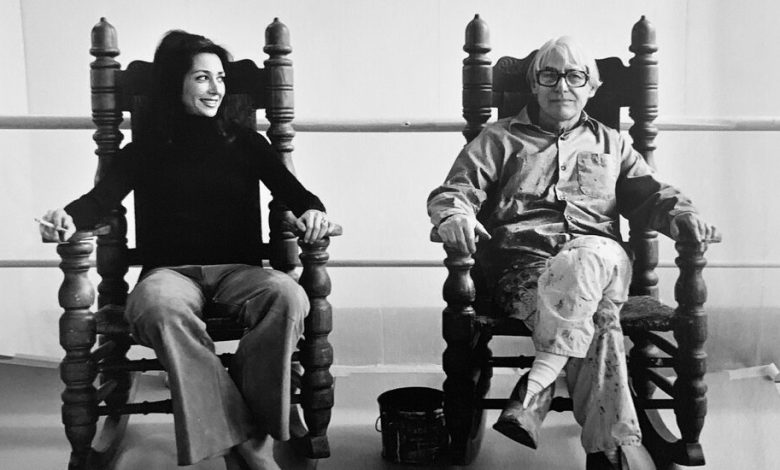Mimi Kilgore, Arts Patron and de Kooning Muse, Dies at 87

In the summer of 1970, the painter Willem de Kooning went on a curious afternoon date with Mimi Kilgore, a radiant young Houston heiress and fixture in the arts world. The outing, a public tour of notable Hamptons homes, was an unlikely way to spend an afternoon for de Kooning. As a titan of 20th-century art who had a house and studio in Springs, an enclave of East Hampton, he was something of a local attraction himself.
But he and Ms. Kilgore, 34 years his junior, had met at a party just weeks before, and already he was smitten. At one house Ms. Kilgore came upon a frog that had been flattened by a car tire. Finding that it reminded her of an abstract shape from one of his paintings, she presented it to de Kooning as a quirky gift. But he saw it as something more. He kept the frog for the rest of his life, a symbol of his devotion to a friend, lover and muse who would remain a source of inspiration for years and who would, by many accounts, help reinvigorate his career.
“It was a classic story of an older artist falling in love with a younger woman,” said the art critic Mark Stevens, who, with his wife, Annalyn Swan, wrote “de Kooning: An American Master,” a Pulitzer Prize-winning 2005 biography. “And in this particular case he seemed to fall in love with painting all over again when he fell in love with Mimi.”
Ms. Kilgore, who died on Nov. 24 in Houston at 87, certainly didn’t need a relationship with a famous man to define her life or career, those who knew her said. Still, her powerful and lasting effect on de Kooning was a testament to the charm, drive and seemingly boundless energy that made her an influential arts patron with a knack for bringing together the art world elite and the moneyed class.
“What really set her apart was her vivacious spirit and sense of humor,” her son Alexander Kilgore, who confirmed the death, said in a phone interview. “She was very passionate about ideas and connected a lot of artists — she connected just a lot of people — that wouldn’t necessarily be connected.”
In Houston, Ms. Kilgore served on the boards of the Museum of Fine Arts and the Contemporary Arts Museum and was twice the commissioner of the Municipal Arts Committee of the City of Houston. On Long Island, she was on the board of Guild Hall, a vibrant arts center in East Hampton.
Ben Love, the chief executive of Texas Commerce bank, hired Ms. Kilgore to build an art collection for the company’s newly built 75-story office tower, which opened in 1982. And for decades she managed the art collection of Fayez Sarofim, a billionaire Houston money manager.
She was also a presence in theater. As a board member of Stages repertory theater in Houston, she helped save its building from developers by arranging for it to be declared a landmark.
And following the death of her sister Susan Smith Blackburn, an actress and writer, from breast cancer in 1977, Ms. Kilgore and Susan’s husband, Bill Blackburn, created a prize in her name, given to English-speaking female playwrights; 10 of its finalists have won Pulitzer Prizes for drama. “She believed that society urgently needed more help from talented women,” her son Alexander said.
Emilie deMun Smith was born on Nov. 13, 1935, in Houston, one of three children of C. Cabanne Smith, a banker who served in Gen. George S. Patton’s Third Army during World War II, and Lucy (Thompson) Smith, an arts patron.
Ms. Kilgore grew up in the wealthy Houston neighborhood of River Oaks, made her debut at the Houston Country Club and attended the private Kinkaid School before heading to Smith College in Massachusetts, from which she graduated magna cum laude in 1957 after a year abroad in France.
Following college, she moved to New York to pursue a career in the art world, taking a job as an art librarian at the Frick Collection. “She studied art at Smith and was wildly excited by the art happening in all mediums in New York,” Mr. Kilgore said. “It was the place to be.”
In 1958, she married William S. Gilbreath III, a financier, and had a son with him, Cabanne Gilbreath, in 1959. The marriage ended in divorce in 1963. Two years later, she married John E. Kilgore Jr., a lawyer from Wichita Falls, Texas, and had her son Alexander with him. In 1970, her father decided to start an oil royalty business in Texas, and she and Mr. Kilgore, along with her two sons, moved to Houston. (The couple divorced in 1985; Mr. Kilgore, who remarried, died in 2005).
Summering in East Hampton as well as in Pointe aux Barques, Mich., an affluent cottage community on Lake Huron that her great-grandfather had helped found, Ms. Kilgore seemed the embodiment of what Mr. de Kooning called a “classy dame,” Mr. Stevens and Ms. Swan wrote in their biography.
The two met at a party at the Bridgehampton home of the Iranian painter Manoucher Yektai in August 1970. “I was sort of transfixed,” Ms. Kilgore recalled in an interview with Mr. Stevens. “I think I was unaware of anything else going on. And we just talked, looking straight at each other for a long, long time. And then he was leaving, and he said, ‘Am I ever going to see you again?’”
He would, frequently, for decades. She visited him until his death in 1997, even after he had slipped into dementia in the 1980s. While the two were never a couple in the formal sense (Ms. Kilgore lived primarily in Texas), they attended art fairs, like the Venice Biennale, and mingled with other artists in New York at the nightclub Max’s Kansas City and Fanelli Cafe, a venerable pub in SoHo.
In the Bohemian art world of postwar New York, appetites for self-indulgence tended to be large, and sexual mores loose, with relationships and romantic partners ever shifting.
For de Kooning, the relationship with Ms. Kilgore proved transformative. Prone to melancholy and given to epic benders, he was in a difficult period in life when he met her, Mr. Stevens said in a phone interview. For starters, he was entangled in stressful relationships both with his wife, the artist Elaine de Kooning, and Joan Ward, the mother of his daughter, Lisa.
Ms. Kilgore provided an escape. “He loved show tunes,” she said in an interview with Mr. Stevens. “We would sing songs together. I loved dancing, so I would dance. And do cartwheels outside the studio near a gazebo.” She tried to teach him to tango, she said, but “his feet were too big.”
Her joie de vivre mesmerized de Kooning. “I love you wherever you are forever,” he wrote in a letter to Ms. Kilgore. “You made me over …. You’re with me all the time even when you’re not with me.”
His joy soon became evident in his work. After a foray into sculpture, de Kooning returned to painting in the 1970s, producing works that were uncharacteristically buoyant and colorful, even lyrical. “They were remarkable for being so rich, luscious and sumptuous — everything you should not have been doing at a time when conceptual art and minimal art were in vogue,” Mr. Stevens said.
His 1976 painting “East Hampton Garden Party,” for example, captured a summery optimism, with its deeply saturated blues and yellows and exuberant brush strokes. It was one of many works that de Kooning would present to a woman he beatified over the years as “Santa Emilia.” With one such gift, he included a letter that said, “I dedicate all my paintings to you.”
In addition to her son Alexander, Ms. Kilgore, who died in an assisted living facility, is survived by her son Cabanne, who is known as Cab, and two grandchildren.
In 1975, de Kooning asked her to marry him. Ms. Kilgore, who was still married, demurred, telling him that “so many lives would be affected” and pointing out that their time apart had actually enriched their relationship.
“The relationship lasted because of what it was,” she told Mr. Stevens. “He could have me the way he wanted me, in his head.”




